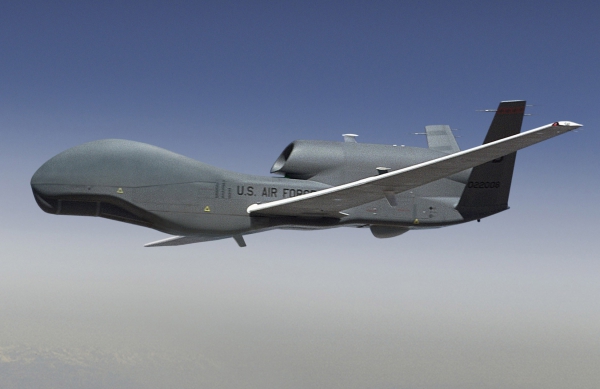The Museum of Aviation at Robins Air Force Base, Warner Robins, Georgia is about to receive an RQ-4 Global Hawk unmanned aircraft that has flown more than 7,000 combat hours – more than any other Global Hawk.The aircraft, #2011, recently retired from active Air Force operational use and is coming to the museum for preservation and display. The Museum of Aviation is only the second museum in the Air Force to obtain a Global Hawk – the first being the National Museum of U.S. Air Force in Dayton Ohio.
It is expected to arrive at Robins Air Force Base aboard a C-5 Galaxy cargo airplane during the week of September 5 and be transported to the Museum of Aviation to eventually be put in an elevated display in the Century of Flight Hangar.
The last flight of #2011 was in May of this year from a base in Southwest Asia to Beale AFB in California, (a distance of more than 7,600 miles) with a single stop at Naval Air Station Patuxent River, Maryland, along the way. During its time in service, the aircraft flew 357 combat sorties for a total of 7,074.4 combat hours and currently has more combat sorties and hours than any other Global Hawk.
The museum’s Global Hawk was part of the first block or group of production aircraft, known as “Block 10.” The US Air Force recently retired its Block 10 aircraft in favor of newer Block 20 and 30 aircraft.
The Command & Control, Intelligence, Surveillance and Reconnaissance Division (C2ISR) of the Warner Robins Air Logistics Center’s Aerospace Sustainment Directorate performs program management for the RQ-4 Global Hawk and other unmanned aircraft systems. ISR functions are principal elements of the United States’ defence capabilities.
The RQ-4 Global Hawk is a high-altitude, long-endurance unmanned aircraft system with an integrated sensor suite that provides intelligence, surveillance and reconnaissance, or ISR, capability worldwide. Global Hawk’s mission is to provide a broad spectrum of ISR collection capability to support joint combatant forces in worldwide peacetime, contingency and wartime operations.
Global Hawk began as an Advanced Concept Technology Demonstration in 1995. The system was determined to have military utility and provide war fighters with an evolutionary high-altitude, long-endurance ISR capability. While still a developmental system, the Global Hawk deployed operationally to support the global war on terrorism in November 2001. The Global Hawk UAS provides near-continuous all-weather, day/night, wide area surveillance and will eventually replace the U-2.
In the RQ-4 name, the “R” is the Department of Defense designation for reconnaissance and “Q” means unmanned aircraft system. The “4” refers to the series of purpose-built remotely piloted aircraft systems.
Source: 13WMAZ

